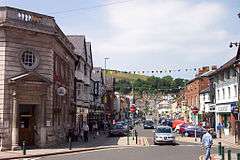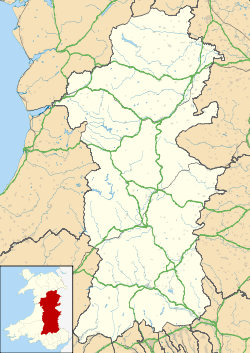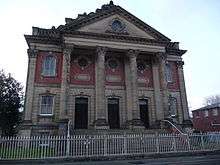Newtown, Powys
Newtown (Welsh: Y Drenewydd), the largest town in the county of Powys, Mid Wales, lies on the River Severn in the community of Newtown and Llanllwchaiarn, within the historic boundaries of Montgomeryshire. It was designated a new town in 1967 and saw population growth as firms settled, changing its market town character. Its 2001 population of 12,783 eased to 11,357 at the 2011 census.[2] It was the birthplace of Robert Owen in 1771, whose house stood on the present site of the HSBC Bank.[3] The town has a theatre, Theatr Hafren,[4] and a public gallery, Oriel Davies, displaying contemporary arts and crafts.[5]
Newtown
| |
|---|---|
 Newtown town centre | |
 Newtown Location within Powys | |
| Population | 11,357 (2011) |
| OS grid reference | SO115915 |
| Community | |
| Principal area | |
| Ceremonial county |
|
| Country | Wales |
| Sovereign state | United Kingdom |
| Post town | NEWTOWN |
| Postcode district | SY16 |
| Dialling code | 01686 |
| Police | Dyfed-Powys |
| Fire | Mid and West Wales |
| Ambulance | Welsh |
| UK Parliament | |
| Senedd Cymru – Welsh Parliament |
|
| Website | www.newtown.org.uk |
History
At the end of the 13th century, Edward I commissioned Roger de Montgomerie to construct a centre for the hamlet of Llanfair-yng-Nghedewain. Situated near a River Severn ford below the Long Bridge and close to the church of St Mary in Bettws Cedewain gave Newtown its original Welsh name.[6]
The foundation is connected to the fate of Llywelyn ap Gruffudd, Prince of Wales, whose new administrative centre at Dolforwyn Castle near Abermule so alarmed Edward I that it was besieged. He seized Llywelyn's lands and granted them to the Mortimers. They transferred the administration of the cantref of Cedewain and the commote of Ceri from Dolforwyn Castle to the new settlement at Newtown.
.jpg)
The town grew in the 18th and 19th centuries around the textile and flannel industry, stimulated by completion of the Montgomeryshire Canal. In 1838, the town saw Wales's first Chartist demonstration.
The Cambrian Mills, opened in 1856, were the first steam-driven mills in Newtown.[7] The mills stood beside the canal terminus on the east bank of the Severn.[8] They expanded to become the largest of the Welsh woollen mills.[7] However, by the end of the 19th century the Newtown mills were no longer competitive with those in the north of England.[7] There was a disastrous fire in 1910 and another in 1912, after which the Cambrian Mills were not rebuilt.[8] Thereafter Newtown was no longer an important centre of the woollen industry and many workers moved elsewhere.[9] Newtown hosted the National Eisteddfod in 1965. In 1967, the town was designated a new town. It saw a large population growth as firms and people settled, changing its rural market town character.
Government
Newtown was governed at local level by Newtown Urban District Council, until this was replaced by Newtown and Llanllwchaiarn Town Council under the Local Government Act 1972. The local government community is Newtown and Llanllwchaiarn,[10] though commonly known as Newtown.
Today's Town Council has 16 elected members serving five-year terms, and employs a staff of about ten.[11] It deals mainly with green spaces and public facilities, and as a representative voice for Newtown. The Council Chair or Mayor, elected by the councillors, has been Councillor Sue Newham since 2017.
The community is represented on Powys County Council by five county councillors, each representing a ward: Newtown Central, Newtown East, Newtown Llanllwchaiarn West, Newtown Llanllwchaiarn West and Newtown South.[10]
Geography
Newtown lies about 8 miles (13 km) from the Wales-England border, in the narrow valley of the River Severn, which restricts development north and south of the town. It is surrounded by small villages, often referred to collectively as the Newtown area. The Newtown post town area, including the villages, has a population approaching 16,000. The villages include Aberhafesp, Adfa, Bettws Cedewain, Bwlch-y-ffridd, Cefn-gwyn, Dolfor, Glanmule, Kerry, Llanllwchaiarn, Llanwyddelan, Mochdre, New Mills, Pentre, Rhydlydan, Sarn and Tregynon.[12]
Buildings and monuments

Built by Pryce Pryce-Jones, the Pryce Jones Royal Welsh Warehouse remains the tallest building in Newtown. The two towering structures housed the world's first mail order service depot.[13]
Bear Lanes, the town's main shopping centre, has a Tudor-style entrance. The building was once a hotel, The Bear, which contributes to the centre's appearance today.
The Robert Owen Museum is on the ground floor of the council offices in Brisco House, Broad Street.[14] A statue of Robert Owen was erected in 1956 in a park off Shortbridge Street and Gas Street. A replica of this was later erected in Manchester.[15]
The Free Library building designed by the architect Frank Shayler of Shrewsbury was built in 1902. The Baptist Chapel, dating from 1881, is a fine example of nonconformist architecture from that period. The Back Lane drill hall was completed in 1897.[16]
Theatres, museums and galleries
Transport
Newtown's station is on the Shrewsbury–Aberystwyth line served by Transport for Wales. Trains run about once in two hours.
Most local bus services in and around the town are operated by local, privately owned companies. Newtown has one National Express bus per day in each direction, to Aberystwyth and to London. Two major roads meet at Newtown: the A483 from Swansea to Chester and the A489 from Machynlleth to Craven Arms. A bypass runs to the south of Newtown, it opened on the 14th February 2019, there had been plans for a bypass around Newtown since 1949[20].
The Montgomery Canal terminated in Newtown. After its closure in 1944, the Newtown section was sold for building land, but it gave its name to Canal Road and Lower Canal Road.
Notable people
In birth order:
- Robert Owen (1771–1858), social reformer and a founder of Utopian socialism and the Co-operative Movement
- John Bentley (1822–1894), member of the Wisconsin State Assembly
- Pryce Pryce-Jones (1834–1920), mail-order entrepreneur born at Llanllwchaiarn, near Newtown
- George Latham (1881–1939), international footballer
- Harry Beadles (1897–1958), Welsh international footballer, born in Llanllwchaiarn, near Newtown
- Geraint Goodwin (1903–1942), novelist and short story writer in English, born in Llanllwchaiarn, near Newtown
- James Crisp (1927–2005), cricketer
- Barry Hoban (born 1940), professional cyclist with several stage wins in the Tour de France
- Philip Parkin (born 1961), professional golfer and commentator
- Phil Mills (born 1963), World Rally Championship winning co-driver
Sports
Newtown A.F.C. is Newtown's association football club, and a founding member of the Welsh Premier League in 1992. The club was founded in 1875 as Newtown White Stars and won the Welsh FA Cup in 1879 and 1895.[21] It also entered the qualifying stages of the UEFA Cup on three occasions. The club plays at Latham Park. This has a capacity of 5,000 (1,750 seated) and a full UEFA licence, allowing under-21 international games and European games to be played. In 2007, another 250-seat stand was built next to the media gantry. Further developments are planned.[22]
Newtown RFC is the town's rugby union club, established in 1925. It currently fields first, second, third, youth and junior teams.[23]
Newtown has facilities for lawn bowls,[24] cricket,[25] and for tennis.[26] A basketball club, the Newtown Titans was set up in 2005, before being reconstituted as Mid-Wales Basketball Club in 2009.[27]
Schools
The Newtown schools are Ysgol Cedewain (special needs), Ladywell Green (ages 4–7), Hafren Junior (7–11), Ysgol Dafydd Llwyd (4–11), St Mary's (4–11), Penygloddfa (4–11), Maesyrhandir (4-11), Treowen (4–11), and Newtown High School and Sixth Form (12–18). The last recently received an outstanding Estyn inspection report in October 2015, praising many features, including teacher/sixth-form pupil relations and school support for a wide range of post-16 vocational and academic subjects. As of 2011, it was proposed that Newtown High School, along with several other schools in Powys, should merge with another county high school, as part of Powys County Council's secondary school and post-16 modernisation programme.[28]
References
- "Newtown".
- "Town population 2011". Retrieved 14 November 2015.
- Biography Retrieved 15 September 2018.
- Theatre site Retrieved 15 September 2018.
- Gallery site Retrieved 15 September 2018.
- Jones, D "Old town, Newtown", in About Wales, November 2007. Civic Trust for Wales.
- Newtown Local History Group (28 February 2014), Newtown Through Time, Amberley Publishing Limited, p. 144, ISBN 978-1-4456-1701-5, retrieved 31 March 2016
- Waiters, Mark (March 2003), An historical and archaeological study of the industrial heritage of Newtown, Powys, Mid Wales, Clwyd-Powys Archaeological Trust, Curatorial Section, p. 16, retrieved 31 March 2016
- Cowey, Carolyn (2016), Pryce-Jones: Pioneer of the Mail Order Industry, BBC, retrieved 31 March 2016
- "Election Maps". Ordnance Survey. Retrieved 27 August 2018.
- Town Council information
- SY16 postcode information
- "Archived copy". Archived from the original on 11 November 2013. Retrieved 11 November 2013.CS1 maint: archived copy as title (link)
- Naomi Penrose (8 March 2017). "Plans to transform Newtown Council HQ". Shropshire Star. Retrieved 18 September 2018.
- Official site Retrieved 15 September 2018.
- "Newtown". The Drill Hall Project. Retrieved 21 August 2017.
- Society site Retrieved 15 September 2018.
- Museum site Retrieved 15 September 2018.
- Lonely Planet Retrieved 15 September 2018.
- "Town's bypass opens after 70-year wait". BBC News. 14 February 2019. Retrieved 28 May 2020.
- Wales – List of Cup Finals
- Official site Retrieved 15 September 2018.
- Club site Retrieved 15 September 2018.
- Club site Retrieved 15 September 2018.
- Club site Retrieved 15 September 2018.
- Club site Retrieved 15 September 2018.
- Basketball site Retrieved 15 September 2018.
- Powys CC plans Retrieved 15 September 2018.